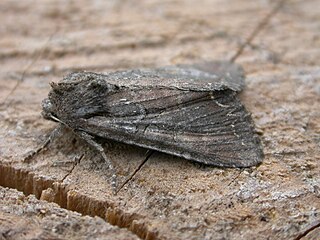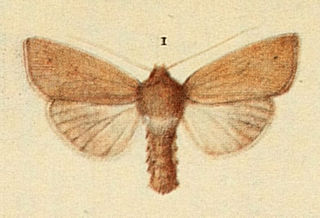
The flame shoulder is a moth of the family Noctuidae. The species was first described by Carl Linnaeus in 1761. It is distributed throughout the Palearctic from Ireland in the west to Siberia then Korea and Japan in the east.

The shoulder-striped wainscot is a moth of the family Noctuidae. The species was first described by Carl Linnaeus in 1761. Some authors place it in the genus Mythimna. It is found throughout Europe and in Russia to the west of the Urals.

The beet armyworm or small mottled willow moth is one of the best-known agricultural pest insects. It is also known as the asparagus fern caterpillar. It is native to Asia, but has been introduced worldwide and is now found almost anywhere its many host crops are grown. The voracious larvae are the main culprits. In the British Isles, where it is an introduced species and not known to breed, the adult moth is known as the small mottled willow moth.

Globia sparganii, or Webb's wainscot, is a moth of the family Noctuidae. The species was first described by Eugenius Johann Christoph Esper in 1790. It is found in Europe, Central Asia, from southern Siberia to Manchuria, Korea, Turkey, Syria and Iran.

Protarchanara brevilinea, or Fenn's wainscot, is a moth of the family Noctuidae. The species was first described by Charles Fenn of Lewisham who collected specimens during an entomological excursion to Ranworth in 1864. It is found in western and northern Europe.

Fissipunctia ypsillon, the dingy shears, is a species of moth of the family Noctuidae. It is found in the Palearctic realm.

Dypterygia scabriuscula, the bird’s wing, is a moth of the family Noctuidae. The species can be found in Europe and the western Palearctic.

The Early Grey(Xylocampa areola) is a species of moth of the family Noctuidae. It is found in Europe and Morocco.

Lacanobia suasa, the dog’s tooth, is a moth of the family Noctuidae. It is found in the Palearctic realm.

Mythimna favicolor, or Mathew's wainscot, is a moth of the family Noctuidae. The species was first described by Charles Golding Barrett in 1896. It is found in Europe. The species is sometimes treated as a subspecies of Mythimna pallens, the common wainscot.

Mythimna obsoleta, the obscure wainscot, is a moth of the family Noctuidae. The species was first described by Jacob Hübner in 1803. It is found in Europe, from southern Fennoscandia to Spain, Italy and the Balkans, the European part of Russia, the Caucasus, Kazakhstan, Kyrgyzia, southern Siberia, Turkey, the Ural, Mongolia, the Russian Far East, the Korean Peninsula, China and Hokkaido and Honshu in Japan.

Mesapamea secalis, the common rustic, is a moth of the family Noctuidae. The species was first described by Carl Linnaeus in his 1758 10th edition of Systema Naturae. It is found in Europe, north-west Africa, Turkey and northern Iran.

The green-brindled dot is a species of moth of the family Noctuidae. It is found in southern Europe and the Middle East, then east to Iran and Ukraine. In Germany it is found up to the Eifel and Ahr.

Grammodes stolida, the geometrician, is a moth of the family Erebidae. The species was first described by Johan Christian Fabricius in 1775. It is found in Africa, southern Europe, most of Asia and Australia. It migrates to central and northern Europe as far north as England, Denmark and Finland.

Xylena vetusta, the red sword-grass, is a moth of the family Noctuidae. The species was first described by Jacob Hübner in 1813. It is found in the Palearctic realm from northwestern Africa through Europe and Asia up to central Siberia. In the north it is found up to the Arctic Circle and Iceland.

Apamea oblonga, the crescent striped, is a moth of the family Noctuidae. The species was first described by Adrian Hardy Haworth in 1809. It is found in northern and central Europe, east to southern Russia, Asia Minor, Armenia, Turkestan, Turkey, Iran, southern Siberia, northern Pakistan, Mongolia, China, Sakhalin and Japan

Archanara dissoluta, the brown-veined wainscot, is a moth of the family Noctuidae. The species was first described by Georg Friedrich Treitschke in 1825. It is found in most of Europe, east into Russia and Siberia.

Meganephria bimaculosa, the double-spot brocade, is a species of moth of the family Noctuidae. It is found in most of Europe, in Turkey and the west of Iran. In Anatolia it is represented by the subspecies Meganephria bimaculosa pontica.

Sideridis turbida, the white colon, is a moth of the family Noctuidae, subfamily Hadeninae. It is found throughout continental Europe, the British Isles and southern Scandinavia.

Callopistria latreillei, Latreille's Latin, is a moth of the family Noctuidae. The species can be found in the Palearctic realm, most parts of Europe, Asia, and in Africa from Egypt to South Africa. The habitat consists of rocky limestone slopes with deciduous woodland.






















